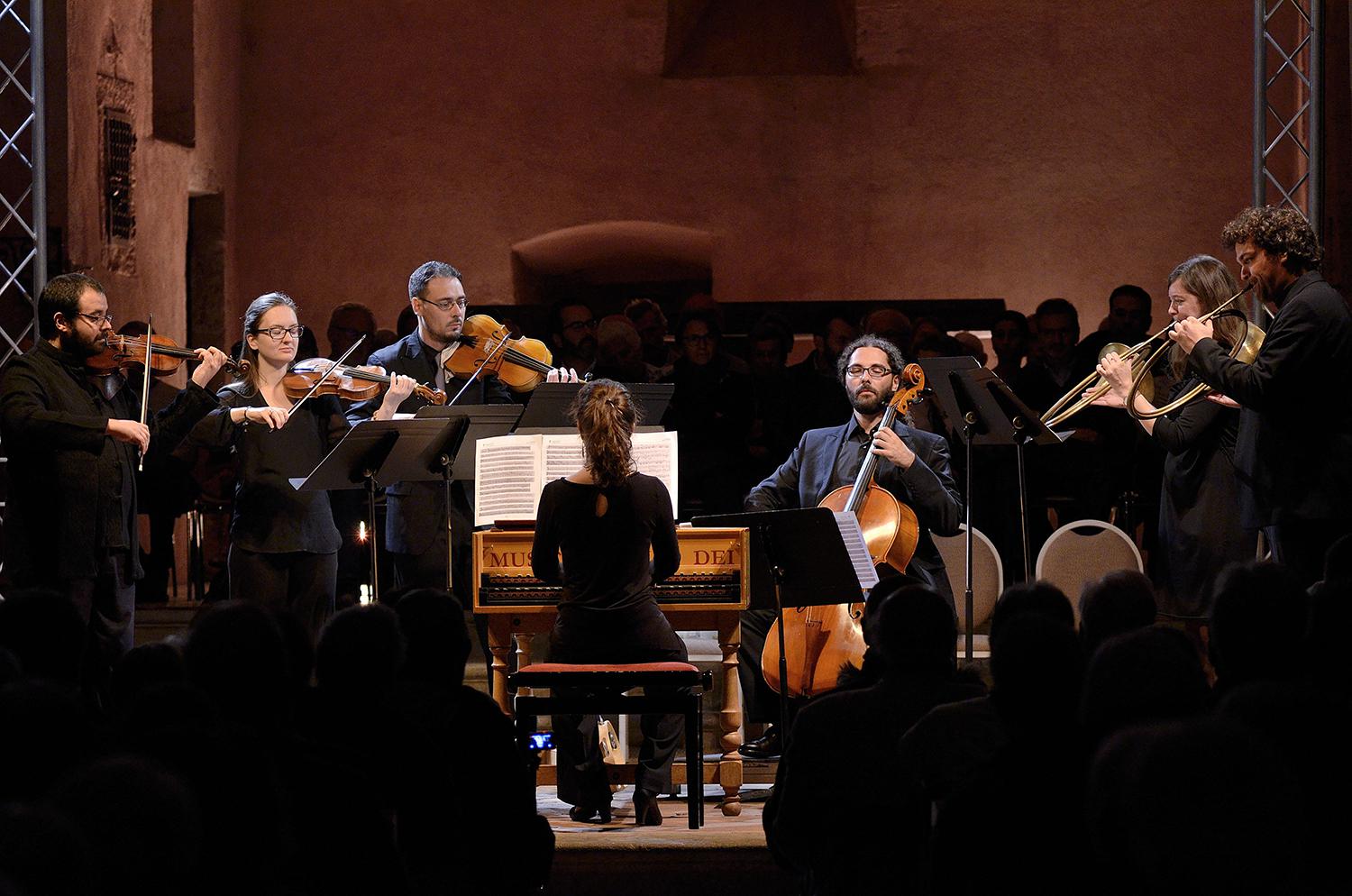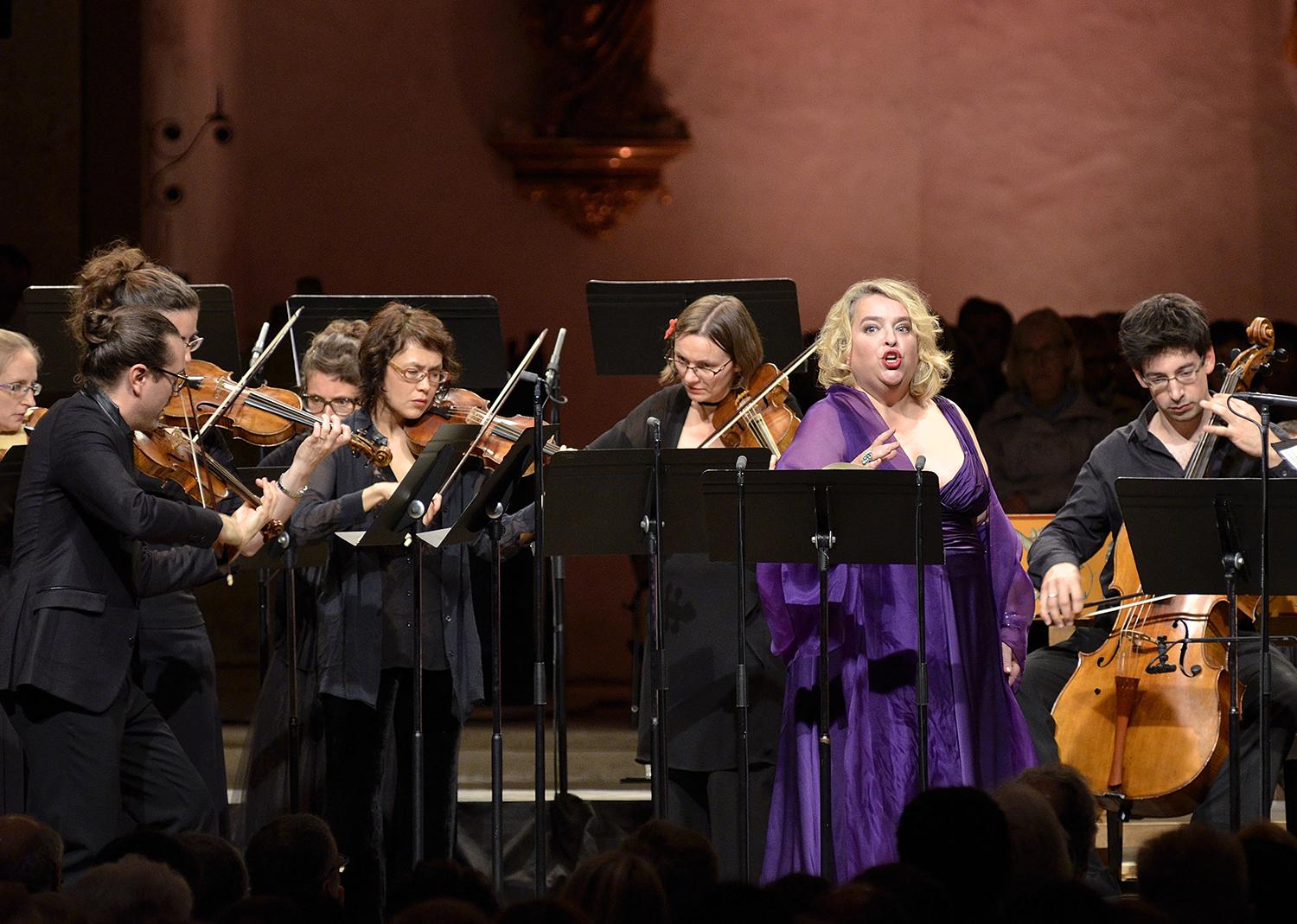[dropcap]I[/dropcap] have probably rehearsed the pleasures of Ambronay sufficiently frequently in EMR to run the risk of repeating myself. So suffice it to say here that it remains the most enchanting and most welcoming of any early music festival venue known to me. To return to Ambronay and its abbey regularly feels tantamount to visiting family and friends. It is always something of a surprise to me that British early music enthusiasts largely have yet to discover the festival that takes place throughout weekends in September every year, given the international quality of the performers and its ease of access from Lyon (just over 50km) with its international airport.
This year’s festival bore the title ‘Vibrations : Souffle’, difficult to render in English since both words can have different meanings, but possibly something along the lines of ‘emotional breaths of wind’. Major events featured included a Monteverdi Orfeo conducted by Leonardo Garcia Alarcón; a recital by Philippe Jaroussky and Christina Pluhar’s L’Arpeggiata; an operatic recital by Karina Gauvin; Handel’s La resurrezione with Accademia Bizantina under their director Ottavio Dantone; a concert of spatial polyphony with the outstanding French ensemble Correspondances directed by Sébastien Daucé; and, for the third year running, a recital of Monteverdi madrigals with Les Arts Florissants and Paul Agnew. Additionally audiences could have found many smaller concerts, lectures and a lively and varied fringe that draws families and locals into the festival experience.
My choice this year fell on the second weekend, covering 21 to the 23 September. In recent years the festival has tended to spread its wings more, taking a number of events out of Ambronay into the surrounding area and this year our first concert (21 Sept) was held in the church of the famous medieval fortress village of Pérouges, some 20 kms away. It featured the ensemble Les Esprits Animaux (LEA), here joined by the cors de chasse of David Guerrier and Anne Boussard in a programme entitled ‘A la chasse’. In the event the hunting element was a relatively minor component of the programme, only one work, Telemann’s Overture in F, TWV 44:8 making specific reference to hunting calls and motifs. The hunting horn is of course a notorious beast to control and if some of the playing was somewhat wayward – especially in Vivaldi’s F major Concerto for 2 horns, RV538 – the players deserve plaudits for courage. In honesty, though, it has to be said that the most satisfying parts of the evening came from the pieces or movements in which the horns were not involved. I first heard LEA at Ambronay in 2011, when they were young artists in residence, at the time praising the ‘strong group personality’. Six years on the players have matured into a truly outstanding chamber ensemble that now plays with real finesse and finish without having lost any of the vitality and evident pleasure they derive from making music together. Among many memorable moments were a delicious, enchantingly elegant performance of Boismortier’s ‘Premier ballet de Village’ and a witty and – in the slow movement – exquisitely shaped performance of Vivaldi’s ‘Il Gardellino’ Flute Concerto, RV428, with LEA’s flautist Élodie Virot as soloist.

The only concert the following day took place in Ambronay’s principal venue, the abbey church that lies at the heart of what is today the cultural centre complex. Comprising principally of a selection of operatic arias mostly featuring ladies in (often considerable) distress, it was given by Canadian soprano Karina Gauvin supported by Le Concert de la Loge under Julien Chauvin, who lead from first violin. The concert was of distinctly variable quality. Gauvin opened with two fierce, furious coloratura arias for the enraged Juno from Graupner’s Dido, Königin von Karthago (1707), in the event an unwise choice that might have been heard to better effect later in the programme when the voice had warmed up. As it was the lack of control, wayward intonation and excessive vibrato spoiled the undeniably dramatic impact of Gauvin’s powerful singing. She was much more effective in the succeeding pair of arias from Alessandro Scarlatti’s late masterpiece, Griselda (1721). Here Gauvin caught the pathetic nuances of ‘Finirà, Barbara sorte’ to touching effect, while finding the note of pride that is a part of the character of the sorely put-upon Griselda in ‘Figlio! Tiranno!’ Here as elsewhere ornamentation was sparse and there were no attempts at a trill in cadenzas. Best of all were a powerful, tragically dramatic account of Alcina’s ‘Ah! mio cor! and one of the encores, an account of ‘Will the sun forget to streak’ from Handel’s Solomon in which Gauvin seemed to find a poise not always evident elsewhere. On their own account Le Concert de la Loge contributed several orchestral extracts and accompanied Gauvin with an icy precision at the opposite polarity to the joyous playing of the previous evening.

The final day of this year’s visit (23 September) provided two concerts, that in the late afternoon featuring the Consone Quartet, one of the young ensembles in the eeemerging competition at Ambronay in 2016. Then I thought their playing of Haydn’s profound late op 77/1 String Quartet showed considerable promise but would eventually benefit from the quartet’s own developing maturity. Now they opened with another rather earlier Haydn quartet, that in C, op 54/2. It was a good performance, with well-judged tempos and some expressive playing in the second part of the Adagio section of the final movement. But leader Agata Daraskaite did not always cope well with the high-lying violin part written for Johann Tost and the performance as a whole would have benefited from a more nuanced approach. It also really should not be necessary for players to re-tune between movements in a work of this length. The Consones seemed in some respects more at home with the romantic lyricism of Schubert’s well-known A-major Quartet, D 804 ‘Rosamunde’. The opening movement was laid out at a moderate tempo that allowed full reign to its inherent expressivity, while the famous ‘Rosamunde’ Andante was given a gracious flow that found room to incorporate a yearning wistfulness. There was an appealing swing to the Menuetto, while the final movement was given a strong rhythmic impetus that accentuated the German dance-like opening theme.

Two years ago Ottavio Dantone and his Accademia Bizantina gave a superb Handel Jephtha at the Beaune Festival, a performance that surprised me by displaying a depth and breadth that I’d not always previously associated with a conductor whose interpretations have at times seemed a touch brittle and or even eccentric. That he seems to have now grown beyond such things was triumphantly underlined by the evening’s performance devoted to an oratorio dating from the other end of Handel’s life, La resurrezione, premiered in Rome in 1708. The demands of the two works are of course totally different. While Jephtha is suffused with the radiant translucent wisdom of Handel’s last years, La resurrezione is the work of a fledgling genius transformed and inspired by his encounter with Italian culture. Dantone caught the spirit of Handel’s youthful exuberance to near-perfection, giving the remarkable accompagnati with which the work abounds full dramatic reign. In these and the arias, many of them demanding virtuoso singing, Dantone was supported by an outstanding solo team, among whom the Angel of the wonderful Hungarian soprano Emőke Baráth stamped her authority from the outset with a dazzling ‘Disserratevi’, every display of coloratura passage work articulated with gleaming accuracy. Lisandro Abadie’s Lucifer was projected with impressive strength and character, his bass having a sufficiently wide range to do justice to the sepulchral low notes incorporated in the role. Camille Poul, a replacement for the indisposed Hasnaa Bennani, sang an affecting Maddelena (Mary Magdalene), shaping her arias with real sensitivity, even if her lower register lacked strength, while the other Mary, Cleofe (Cleophas) was vividly communicated by the experienced alto Delphine Galou, whose attention to text, music and drama were throughout exemplary. Completing this exceptional line up, the San Giovanni (St John) of Martin Vanberg was notable above all for its refined musicality, the voice owning to a cultured liquid lyricism also capable of accurate passaggi. Add to these remarkable assets superbly alert and beautifully finished playing by Accademia Bizantina and this was a performance that confirmed Ottavio Dantone’s now established place as one of today’s leading Handel conductors.
Brian Robins
